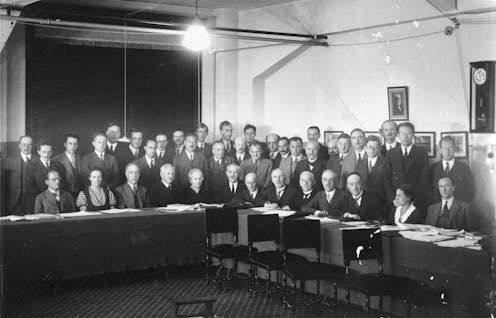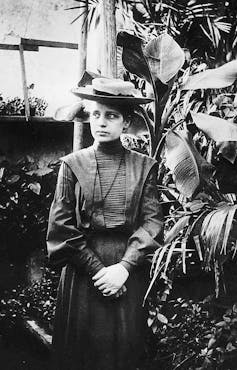
Christopher Nolan’s highly-anticipated movie “Oppenheimer,” set for release July 21, 2023, depicts J. Robert Oppenheimer and his role in the development of the atomic bomb. But while the Manhattan Project wouldn’t have been possible without the work of many accomplished female scientists, the only women seen in the movie’s trailer are either hanging laundry, crying or cheering the men on.
As a physics professor who studies ways to support women in STEM – science, technology, engineering and math – fields and a film studies professor who worked as a screenwriter in Hollywood, we believe the trailer’s depiction of women reinforces stereotypes about who can succeed in science. It also represents a larger trend of women’s contributions in science going unrecognized in modern media.
Lise Meitner: A pioneering role model in physics
The Manhattan Project would not have been possible without the work of physicist Lise Meitner, who discovered nuclear fission. Meitner used Einstein’s E=MC² to calculate how much energy would be released by splitting uranium atoms, and it was that development that would prompt Einstein to sign a letter urging President Franklin Roosevelt to begin the United States’ atomic research program.
Einstein called Meitner the “Madame Curie of Germany” and was one of a pantheon of physicists, from Max Planck to Niels Bohr, who nominated Meitner for a Nobel Prize 48 times during her lifetime.

Meitner never won. Instead, the prize for fission went to Otto Hahn, her male lab partner of 30 years in Berlin. Hahn received the news of his nomination under house arrest in England, where he and other German scientists were being held to determine how far the Third Reich had advanced with its atomic program.
Of Jewish descent, Meitner had been forced to flee the Nazis in 1938 and refused to use this scientific discovery to develop a bomb. Rather, she spent the rest of her life working to promote nuclear disarmament and advocating for the responsible use of nuclear energy.
Meitner was not the only woman who made a significant contribution during this time. But the lack of physics role models like Meitner in popular media leads to real-life consequences. Meitner doesn’t appear as a character in the film, as she was not part of the Manhattan Project, but we hope the script alludes to her groundbreaking work.
A lack of representation
Only around 20% of the undergraduate majors and Ph.D. students in physics are women. The societal stereotypes and biases, expectation of brilliance, lack of role models and chilly culture of physics discourage many talented students from historically marginalized backgrounds, like women, from pursuing physics and related disciplines.
Societal stereotypes and biases influence students even before they enter the classroom. One common stereotype is the idea that genius and brilliance are important factors to succeed in physics. However, genius is often associated with boys, and girls from a young age tend to shy away from fields associated with innate brilliance.
Studies have found that by the age of 6, girls are less likely than boys to believe they are “really, really smart.” As these students get older, often the norms in science classes and curricula tend not to represent the interests and values of girls. All of these stereotypes and factors can influence women’s perception of their ability to do physics.
Research shows that at the end of a yearlong college physics course sequence, women with an “A” have the same physics self-efficacy as men with a “C”. A person’s physics self-efficacy is their belief about how good they are at solving physics problems – and one’s self-efficacy can shape their career trajectory.
Women drop out of college science and engineering majors with significantly higher grade-point averages than men who drop out. In some cases, women who drop out have the same GPA as men who complete those majors. Compared to men, women in physics courses feel significantly less recognized for their accomplishments. Recognition from others as a person who can excel in physics is the strongest predictor of a student’s physics identity, or whether they see themselves as someone who can excel in physics.
More frequent media recognition of female scientists, such as Meitner, could vicariously influence young women, who may see them as role models. This recognition alone can boost young women’s physics self-efficacy and identity.
When Meitner started her career at the beginning of the 20th century, male physicists made excuses about why women had no place in a lab – their long hair might catch fire on Bunsen burners, for instance. We like to believe we have made progress in the past century, but the underrepresentation of women in physics is still concerning.

Diversity as an asset to science
If diverse groups of scientists are involved in brainstorming challenging problems, not only can they devise better, future-oriented solutions, but those solutions will also benefit a wider range of people.
Individuals’ lived experiences affect their perspectives – for example, over two centuries ago, mathematician Ada Lovelace imagined applications far beyond what the original inventors of the computer intended. Similarly, women today are more likely to focus on applications of quantum computers that will benefit their communities. Additionally, physicists from Global South countries are more likely to develop improved stoves, solar cells, water purification systems or solar-powered lamps. The perspectives that diverse groups bring to science problems can lead to new innovations.
Our intention is not to disparage the “Oppenheimer” movie, but to point out that by not centering media attention on diverse voices – including those of women in physics like Meitner – filmmakers perpetuate the status quo and stereotypes about who belongs in physics. Additionally, young women continue to be deprived of exposure to role models who could inspire their academic and professional journeys
The authors do not work for, consult, own shares in or receive funding from any company or organisation that would benefit from this article, and have disclosed no relevant affiliations beyond their academic appointment.
This article was originally published on The Conversation. Read the original article.







